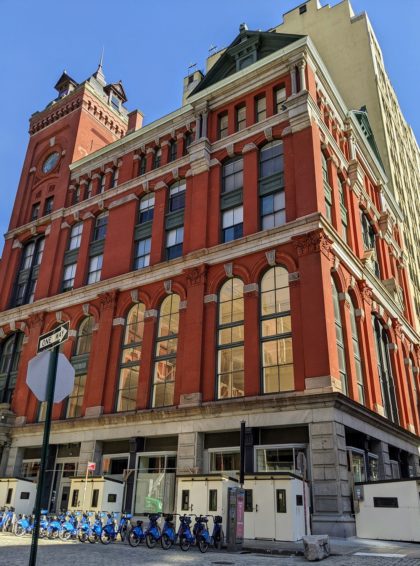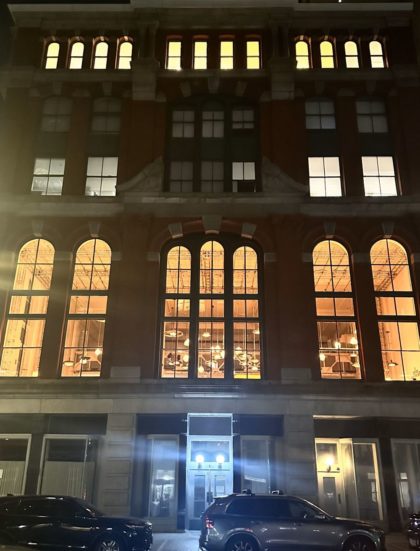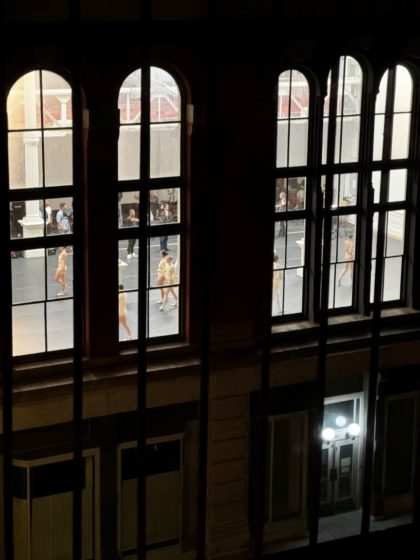Nosy Neighbor: What’s happening at the New York Mercantile Exchange?
The New York Mercantile Exchange, the historic building at 2 Harrison on the corner of Hudson, was gutted over the past few years and several people have been asking what’s going on there… Luckily S. has kept a watch on it for us (that’s her photo of the dance performance from mid-October, and a photo from G. this week), both from above and in the papers. (The building is in the Tribeca West Historic District, but not a landmark itself.)
She also happened to be reading Architectural Digest and saw that design firm Roman and Williams has taken the space through Dec. 1 for an exhibition of its lighting fixtures. The show is called “A Certain Slant of Light,” named for the Emily Dickinson poem, and will feature 100 lights including 12 new designs, “from alabaster pendants to sculptural sconces, some with fixed metal shades, others with cast or blown glass,” as described in AD. “Burnished brass forms a through line, though here again no average alloy would do: It had to be a certain French brass, distinguished by the copper content that results in warmer tones. Standefer says it best: ‘We are just mesmerized by materials.'”
The design firm has also moved its offices to another old mercantile building: the National City Bank of New York building at 296 Canal aka 415 Broadway aka 65 Lispenard, on the southwest corner with Broadway. The rest of that building has been an immersive art show — INTER_ — for the past couple years. Here’s the text on that from the Tribeca East Historic District designation report from 1992, when Citibank was the tenant, just for fun:
Designed by the distinguished firm of Walker & Gillette, this structure was erected in 1927 for the National City Bank of New York, an institution which descended from Alexander Hamilton’s Federal Bank and developed as a mercantile bank for the cotton, sugar, metal, and coal interests. Previously on this site stood several structures which in 1851 were occupied by dealers in hardware and pianos, by a carver, and an African-American, William J. Wilson, a maker of boots and shoes. These buildings were replaced in 1860 by the Brandreth House, a hotel which included among its commercial tenants the Western Union Telegraph Company and James L. Palmer, an importer and jobber of European fancy goods. The hotel featured a cast- iron base manufactured by Daniel D. Badger’s Architectural Iron Works.
The existing structure, a steel-frame building sheathed in limestone, expresses the Moderne style in its compact massing, smooth surfaces featuring curved corners and streamlined elements, and bold, abstracted ornament used with restraint. On the Broadway facade, the large central opening, its linear frame surmounted by an eagle-flanked bronze shield, retains its multipane steel transom. Each of the symmetrically arranged facades on Canal and Lispenard streets exhibits projecting end bays with double-hung steel windows and the inscription “AD 1812” and “AD 1927,” and a five-bay central section with large openings filled with tripartite steel windows at grade, patterned spandrels, and multipane steel windows. Upper-story openings have paired double-hung steel windows.
















Proenza Schouler had their September fashion week show at the Mercantile Exchange. Nice video of the space linked at:
https://ahandtailoredsuit.com/blogs/off-the-cuff/new-york-fashion-week-september-2024-proenza-schouler
Oh thank you! Kept forgetting I wanted to write you to see if you knew what was up with the lights—which are right across from my bedroom window. They’re gorgeous! No issue! Was just verrrrry curious!